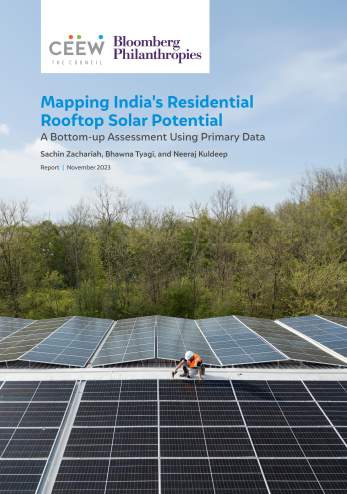Report
Assessing and Planning for Variability in India’s Wind Resource
Jai Shekhar, Selna Saji, Disha Agarwal, Asim Ahmed, Tarun Joseph
August 2021 | Energy Transitions
Suggested Citation: Shekhar, Jai, Selna Saji, Disha Agarwal, Asim Ahmed, and Tarun Joseph. 2021. Assessing and Planning for Variability in India’s Wind Resource. New Delhi: Council on Energy, Environment and Water.
Overview
This study examines the decline in India’s wind energy generation during the peak monsoon season of 2020, outlines the micro and macro impacts of this anomaly and identifies potential solutions for climate-proofing the sector. It undertakes case studies to assess the extent of variability observed across farms in wind-rich states, identifies the underlying reasons, and examines the associated operational and financial implications for the stakeholders. It analyses the annual average wind speeds across 40 years for three states, Gujarat, Rajasthan and Tamil Nadu. It also assesses the daily average wind speeds between June and September for two districts - Jamnagar, Gujarat and Tirunelveli, Tamil Nadu. Further, it discusses the strategies to improve the wind resource predictability in India, and other interventions to ensure the sector’s preparedness to deal with emerging climate-induced risks.
With India’s ambitious targets of reaching 60 GW of wind power capacity by 2022 and estimates of 140 GW by 2030, wind power is and will continue to be an important constituent of India's electricity mix and decarbonisation journey. It is thus necessary to anticipate any potential risks to the accelerated development of the sector. Given that effects of climate change are becoming rampant all across the globe, it is likely that the future sees an increased frequency and intensity of anomalies in wind speeds and patterns. More robust and long-term climatological analyses are required to increase preparedness.
Key Highlights
- The national wind energy generation was 24 per cent lower during June–September 2020, relative to the same period in 2019. The western and southern regions experienced a 29 per cent and 17 per cent decline in wind power generation, respectively, during this period. This fall was unanticipated.
- In the last quarter of 2020, the wind speeds picked up and compensated for the dip during the monsoon months. Therefore, the overall reduction in wind power generation in 2020 (when compared with 2019) was 5.3 per cent. In 2020, three abnormal deviations during the pre-monsoon season led to slow wind speeds. These are:
- A cooler than usual northern plains of the Indian subcontinent.
- Warmer than normal water bodies around the Indian peninsula.
- Wetter than normal pre-monsoon season in India.
Anomalies in the Indian summer monsoon of 2020 disrupted wind fields during the peak season

Source: Authors’ analysis
- An analysis of wind speeds over 40 years (1979 to 2019) across India shows that average annual speeds at 100 metres are decreasing at the rate of 0.88 kmph/decade. The sharpest declines occurred in June (-1.33 kmph with every decade) and July (-1.27 kmph with every decade). Gujarat and Tamil Nadu are the only states that continue to experience an annual average wind speed greater than 15 kmph. More granular studies are needed to understand localised changes.
- Anomalous weather events can have implications on real-time system balancing and affect cash flows for developers. The analysis shows that a 10 per cent drop in the Capacity Utilisation Factor (CUF) for five years during a wind power plant’s life could lower the Equity Internal Rate of Return (EIRR) by 1.83 percentage points. This drop in EIRR, in turn, translates to a reduction of INR 122 crore in the total revenue. If such events become more frequent, profit margins can reduce amidst stiff competition present in the RE sector.
- Various unforeseen climate-induced changes in wind speeds and patterns need to be anticipated through advanced modelling techniques, for robust planning and operations. Other risk-proofing strategies, learning from other countries, and climatological assessments to forecast the frequency and intensity of such anomalous and extreme events in the future, must be discussed.
Key Recommendations
To climate-proof the wind energy sector, governments, public sector organisations, and the wind industry must invest in deep climatological research and modelling, adopt advanced weather and generation forecasting techniques, and enable cost-effective ancillary support services.
Interventions needed to minimise the effects of wind resource variability

Source: Authors’ analysis
Climate-induced variability in wind resources is an emerging risk that we do not know enough about. Deep climatological research using granular data can equip us to plan ahead in time.







